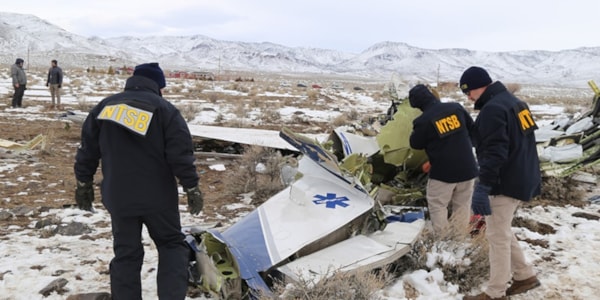Control tower warns pilot about turbulence before PC-12 breaks apart midair

The Pilatus PC-12 air ambulance was making a descending right turn when it lost ADS-B contact, crashing into flat, sagebrush-covered, high desert terrain 0.31 miles northeast of the last ADS-B target. When the pilot told the Air Route Traffic Control Center the plane was climbing to 15,400 feet, he was told to maintain flight level and was issued a caution for light to moderate turbulence, which he then acknowledged. In a press conference after the crash, the NTSB said that the aircraft broke apart in midair and killed all five people on board. The NTSB prelim states that multiple witnesses heard the plane flying overhead followed by the sound of an impact with the terrain.
RELATED STORY:
Pilatus PC-12 medical flight breaks apart midair, killing all 5
On Feb. 24, the PC-12 (N273SM) operated as a medical transport flight left the Reno-Tahoe International Airport (RNO) heading to Salt Lake City International Airport (SLC) and was in the air for about 14 minutes before it lost contact with the ATC. According to the report, night instrument meteorological conditions were noted at the time of the crash and an IFR flight plan was filed and activated. It was overcast and clouds were scattered, visibility was 1.75 miles, the wind was at four knots, it was about 30 degrees Fahrenheit and winter weather was reported. In the press conference, NTSB Vice Chairman Bruce Landsberg had said that the weather that evening would not have precluded the plane from flying. The Lyon County Sheriff’s Office said it took over two hours to find the wreckage due to the snow.
The plane departed runway 17L at RNO, consistent with the ZEFFR 7 RNAV departure procedure and continued a southerly heading. A left turn to a southeasterly heading near the EPOSE waypoint was observed at about 12,100 feet mean sea level (msl) and the aircraft continued its ascent until a northeastern turn was observed at 15,700 feet msl at around the WITTT waypoint.
The plane ascended to about 18,300 feet and made a right turn to a southeasterly heading roughly two miles from the DATTT waypoint. ADS-B data revealed the plane remained on this heading for approximately 47 seconds before ascending to 18,900 feet msl and turning left to a northeasterly heading. The plane continued to about 19,100 feet before entering a descending right turn. It remained in the descending right turn, dropping 8,000 feet in about 30 seconds and losing ADS-B contact at 11,100 feet msl.
Witnesses surrounding the accident site told the NTSB they heard the plane flying overhead and then the sound of an impact. The accident site revealed the plane had impacted a flat, sagebrush-covered, high desert terrain at about 0.31 miles northeast of the last noted ADS-B target and the wreckage debris field extended to about 0.9 miles southwest of the main site.

The main wreckage included the fuselage, left wing, inboard right wing, vertical stabilizer and rudder, which were oriented upright on a magnetic heading of about 018 degrees. The report said the suspected point of initial impact contained debris from the airframe and a propeller blade. The fuselage was crushed vertically with a large hole above and at the aft of the rear cargo door. The vertical stabilizer and rudder had remained partially attached to the fuselage and the left wing was mostly intact and attached. The left aileron was partially attached and the left flap had separated. The right inboard wing was found mostly intact and it was attached to the fuselage with the inboard position of the right flap attached.
There were two pieces of the right aileron, parts of the right flap and pieces of the right-wing structure located about 0.70 miles southwest of the main wreckage. Two sections of the outboard right wing were found about 0.34 miles southwest, the right horizontal stabilizer was about 0.52 miles southwest, and the left horizontal stabilizer was found 0.33 miles southwest of the main site. All parts recovered were taken to another location for examination.

The prelim does not mention the winter storm at the time of the flight as a factor. It was also mentioned in the press conference at the time of the crash that the NTSB did not believe the wintry weather played a factor in the incident. The report did not mention the aircraft breaking apart midair, which is what was stated as a possible cause in the press conference.
The flight was operated by Guardian Flight with Care Flight and was the fourth incident involving Guardian Flight medical transport planes. A passive stand down for all Guardian and Care Flight flights in the country was issued and a GoFundMe was set up for the family of the patient and his wife killed in the crash. The previous incidents involved different makes and models and two of the other incidents were fatal. A plane went down in the ocean near Maui and killed all crew on board and another went down in the Canada-Alaska area and parts of the plane and the victim’s bodies were not recovered. A third non-fatal incident involved an autopilot malfunction in Arizona that resulted in no injuries or aircraft damage.
RELATED STORIES:
Air ambulance that crashed near Maui was off course, NTSB prelim says
Coast Guard calls off search for air ambulance crash near Maui
The investigation into the cause of the PC-12 crash is ongoing and a final report takes a year or more to come out.
Contact
Name: Haley Davoren
, Digital Content Manager
Company: GlobalAir.com
Website: https://globalair.com
Email: [email protected]
Phone: 502-456-3934
©2023 GlobalAir.com, Haley Davoren. All rights reserved.



Recent Comments